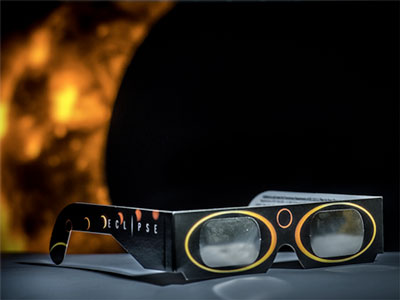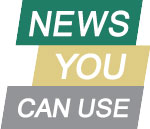Media contact: Alicia Rohan, arohan@uab.edu
 Watching the captivating sight of the moon’s passing between the sun and Earth, where the moon fully or partially covers the sun, could cause serious and potentially long-term harm to the eye if not viewed properly. Eye specialists from the University of Alabama at Birmingham offer tips on eye safety during the eclipse to avoid post-exposure symptoms like pain, red eyes, light sensitivity, tearing or watery eyes, blurry vision, and many others.
Watching the captivating sight of the moon’s passing between the sun and Earth, where the moon fully or partially covers the sun, could cause serious and potentially long-term harm to the eye if not viewed properly. Eye specialists from the University of Alabama at Birmingham offer tips on eye safety during the eclipse to avoid post-exposure symptoms like pain, red eyes, light sensitivity, tearing or watery eyes, blurry vision, and many others.
“It is never safe to stare directly into the sun, and that includes during the eclipse,” said Tamara S. Oechslin, O.D., Ph.D., assistant professor in the UAB School of Optometry. “Parts of the country will see partial coverage, while others will see full coverage. It will never be safe to view the eclipse without eye protection unless you are in a zone with complete coverage and, then, only during those two minutes of complete coverage, or totality.”
According to NASA, all of North America will be treated to an eclipse of the sun Monday, Aug. 21. This is the first of its kind in the United States since 1979. Anyone within the path of totality can see a total solar eclipse, and observers outside this path will see a partial solar eclipse. NASA released the 2017 total solar eclipse path map to help viewers identify the amount of coverage that will be seen in their area. Viewers can also use the interactive solar eclipse Google map to find the type of eclipse that will be seen in a particular region.
“The best option to view an eclipse safely is to wear solar eclipse glasses approved by the International Organization for Standardization, which can be purchased from various online merchants,” said Tyler A. Hall, M.D., assistant professor from the UAB School of Medicine’s Department of Ophthalmology.
 Tyler A. Hall, M.D.Standard sunglasses, regardless of ultraviolet markings, including UVA and UVB, will not provide enough protection for eclipse viewing due to the intensity of the rays. The sun’s rays may be partially blocked during an eclipse, but the remaining visible rays are still intense enough to cause serious eye damage or even loss of vision. Protective eyewear should have an ISO 12312-2 marking on them to be considered safe for looking at the sun.
Tyler A. Hall, M.D.Standard sunglasses, regardless of ultraviolet markings, including UVA and UVB, will not provide enough protection for eclipse viewing due to the intensity of the rays. The sun’s rays may be partially blocked during an eclipse, but the remaining visible rays are still intense enough to cause serious eye damage or even loss of vision. Protective eyewear should have an ISO 12312-2 marking on them to be considered safe for looking at the sun.
When a viewer is in the total coverage zone and during the brief two-minute period of total coverage, the solar eclipse can be viewed without wearing the approved eclipse glasses. The sun’s rays are blocked in this zone, allowing viewers to remove the glasses for a brief time to see the total eclipse. Viewers in the partial eclipse zones should wear protective eyewear the entire time.
“The only exception to the rule of strictly wearing solar eclipse glasses while viewing the eclipse is that you can remove your eclipse glasses if you are viewing a total eclipse when all the sun’s rays become blocked,” Hall said. “Most people, however, will be viewing a partial eclipse, which should be seen only through solar eclipse glasses.”
Oechslin suggests the only safe way to look directly at the uneclipsed or partially eclipsed sun is through special-purpose solar filters, such as eclipse glasses or hand-held solar viewers. She suggests certain filters to view the solar eclipse, including specialty eclipse glasses or a welder’s helmet shade #14 or higher.
An educational activity she recommends for kids is to make pinhole cameras for viewing the shadow of the moon’s path across the sun. However, these cameras are not to look through, but to watch the small shadow on the ground. Directions for making a pinhole camera and its use can be found online.
Oechslin highly recommends NASA’s do’s and don’ts while viewing the solar eclipse:
- Always inspect your solar filter before use; if scratched or damaged, discard it. Read and follow any instructions printed on or packaged with the filter. Always supervise children using solar filters.
- Stand still and cover your eyes with your eclipse glasses or solar viewer before looking up at the bright sun. After glancing at the sun, turn away and remove your filter – do not remove it while looking at the sun.
- Do not look at the uneclipsed or partially eclipsed sun through an unfiltered camera, telescope, binoculars or other optical device. Similarly, do not look at the sun through a camera, a telescope, binoculars or any other optical device while using your eclipse glasses or hand-held solar viewer — the concentrated solar rays will damage the filter and enter your eye(s), causing serious injury. Seek expert advice from an astronomer before using a solar filter with a camera, telescope, binoculars or any other optical device.
- If you are within the path of totality and only during the brief two-minute period of totality, remove your solar filter only when the moon completely covers the sun’s bright face and it suddenly gets quite dark. Experience totality; then, as soon as the bright sun begins to reappear, replace your solar viewer to glance at the remaining partial phases.
 Tamara S. Oechslin, O.D., Ph.D.There are no specific alerts to stop someone from looking directly at an eclipse in order to avoid damage irrespective of whether they are wearing appropriate eclipse glasses. Hall recommends limiting viewing the solar eclipse to three minutes or less, even with approved solar eclipse glasses.
Tamara S. Oechslin, O.D., Ph.D.There are no specific alerts to stop someone from looking directly at an eclipse in order to avoid damage irrespective of whether they are wearing appropriate eclipse glasses. Hall recommends limiting viewing the solar eclipse to three minutes or less, even with approved solar eclipse glasses.
“If the essential guidelines are adhered to, eye damage is extremely unlikely to occur,” Hall said. “Should damage occur, it typically takes the form of blurred vision or blind spots that develop several hours after the viewing occurred.”
Ocular damage from the sun can be rather serious and can severely damage the front surface and inside of the eye. Two types of eye damage can occur from overexposure to the sun: photokeratitis, damage to the front surface, and solar retinopathy, damage to the inside or back of the eye.
“Persons should seek medical attention immediately if experiencing any post-exposure symptoms, especially if the condition is worsening with time,” Oechslin said. “Just as with a sunburn, delayed symptoms can also occur several hours after overexposure.”
Symptoms of photokeratitis include eye pain, burning or red eyes, light sensitivity, blurred vision, watery eyes, and/or swelling around the eye or eyelid. In the case of sunburned eyes, one should remove any contact lenses, use a cold compress and preservative-free artificial tears, and immediately call an eye care professional who will be able to help with the pain and any inflammation. To decrease irritation, contact lenses should not be worn, and one should not rub the eye. Patients are encouraged to stay in a dark room or wear sunglasses until symptoms have subsided.
Signs of solar retinopathy may be blurred vision that does not improve with glasses or contact lenses, light sensitivity, blind spot in one or more commonly both eyes, watery eyes, eye soreness, difficulty in recognizing shapes, objects’ appearing distorted, and headaches. Patients are advised not to gaze directly at sunlight and to immediately seek help from an eye care professional to help ease the discomfort of symptoms and to assess the amount of damage. If the damage is severe, there may be a permanent loss of vision, which is why following the precautionary methods while viewing the eclipse is mandatory.
One should start by calling or visiting their eye care professional’s office, as their own doctor will have an ocular history for the patient and know the proper treatment or best referral network. If the person has not had a recent eye exam, local urgent care and emergency departments should be able to treat and refer these eye conditions.
 A UAB optometrist and ophthalmologist provide advice on how to protect your eyes while viewing the solar eclipse.
A UAB optometrist and ophthalmologist provide advice on how to protect your eyes while viewing the solar eclipse.